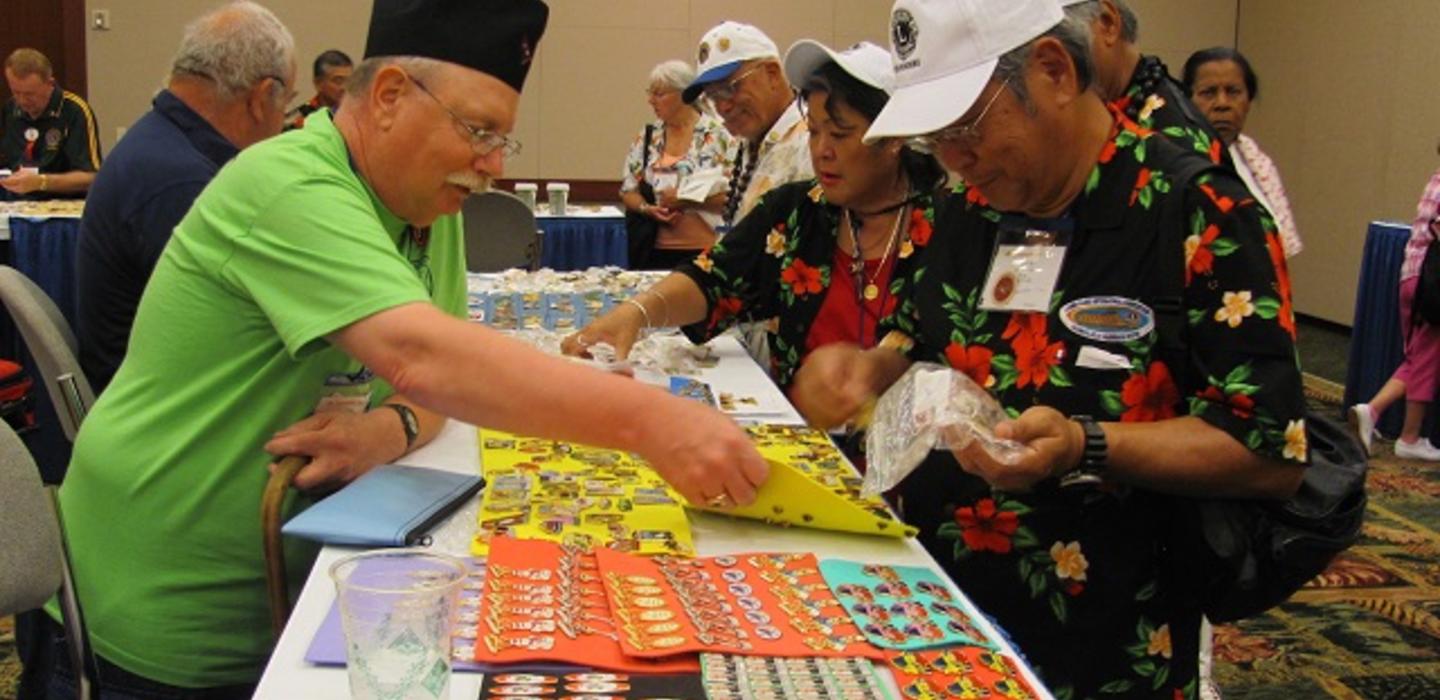Glittering squares of gold on a lapel, shaped like lions’ heads or in the outlines of states. These emblems are colorful reminders of past accomplishments, international conventions or new friends.
Lions Clubs International pins come in all shapes and sizes today, but they were introduced in the late 1940s as disposable plastic parade giveaways. Those early emblems, called friendship pins, are now highly sought after by pin collectors and traders.
Trying to count up all of the different pins that have been produced over the intervening decades “is like trying to count grains of sand on a beach,” said Verle Malik of the Winchester Host Lions Club of Virginia. Verle publishes a series of handbooks cataloging the different kinds of pins, one of several catalogs produced by clubs and Lions around the world. Volume One of Verle’s handbook included life-size images of pins from every state and multiple district, and Volume Two featured specialty pins: prestige, mini, medallion, charm, stickpins, Lioness, Leo and variations on pins issued by states and multiple districts. Volume Three included international pins.
“These are friendship pins,” said Verle. “They were initially made to help you remember the person that gave it to you. You exchange them everywhere you go and pass them out to everyone you visit. Once you accumulate a few of them—the pin traders will appear.”
The biggest place to trade pins is the annual International Convention, but for Lions who can’t make it—or for Lions who want more opportunities to trade—there several large pin-swapping gatherings held throughout the year in Virginia; Pennsylvania; Las Vegas, Nevada; and Moline, Illinois. Smaller local swaps also occur regularly.
Pin swapping is a friendly affair, but there’s a strategy involved. “You’ve got to have pins to trade,” said Bob Showers, longtime pin swapper from the Packwaukee Lions Club in Wisconsin. “If you go down there with mediocre pins, you’re not going to get very many.”
There are a number of official pin trading clubs within Lions. According to Bill Smith, the founding president of the Pin Traders Club of Virginia, they’re eager to bring in new collectors. “When we find out a guy’s a new pin trader, he leaves [the swap] with far more pins than he came in with. We’ll give him a handful of pins. We’re just trying to hook him.”
Lions collect and trade more than pins. At the 1951 international convention in Atlantic City, New Jersey, the Lions International Stamp Club was officially chartered. Peter Keller, founder of the LISC and director of the American Stamp Dealers Association, authored a regular stamp collecting column in LION Magazine, calling stamp collecting “the King of Hobbies and the Hobby of Kings.”
Within a year, the LISC had members from five countries, collecting and trading rare or interesting stamps of all kinds. Since 1940, countries such as Cuba, the Philippines and Nicaragua have issued commemorative stamps featuring the Lions Clubs International emblem and past international presidents like Finis Davis of Louisville, Kentucky, who served from 1960-61, and Clarence Sturm from Manawa, Wisconsin, who served from 1959-60.
As with anything that Lions are involved in, fun and fellowship leads to service. In 2008, the Lions International Trading Pin Club led a fundraising effort among fellow pin traders and presented a check for US$100,000 to Campaign SightFirst II at the International Convention in Minneapolis the following year.
Trading pins and stamps is a hobby that’s entertaining and a celebration of Lions’ dedication to service. “I don’t golf, I don’t bowl,” said Bill Smith. “
Pins are my passion. And I’m not unique in that.”
Explore the exciting history of Lions Clubs International with our exclusive Touchstone Stories series.

